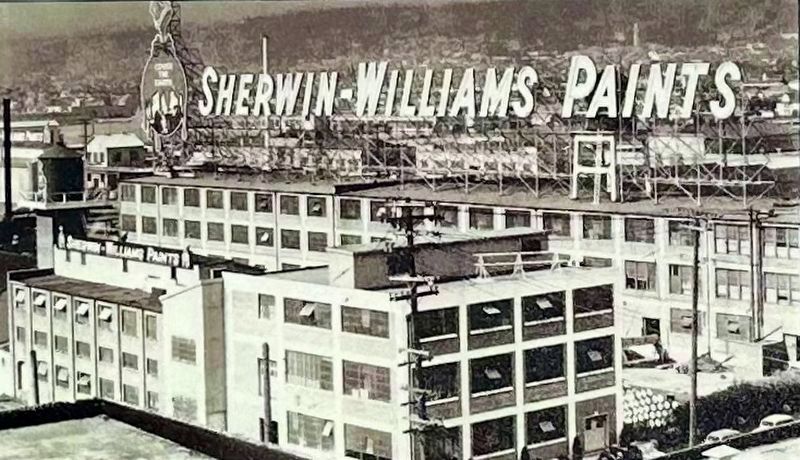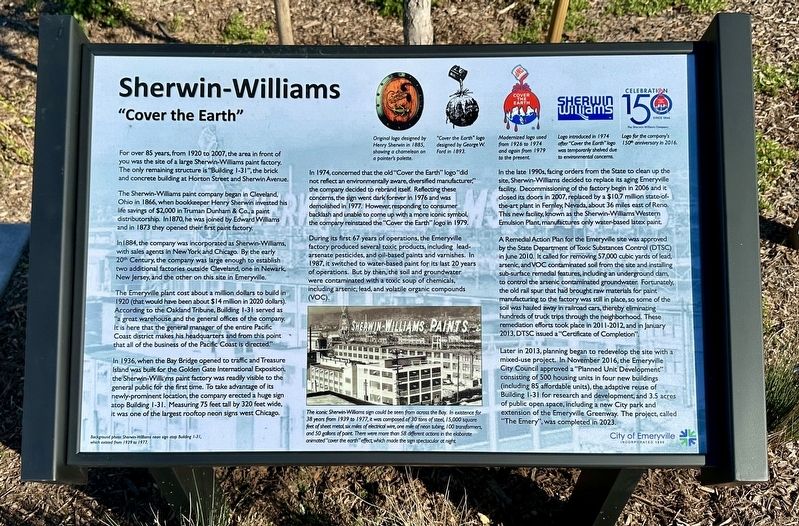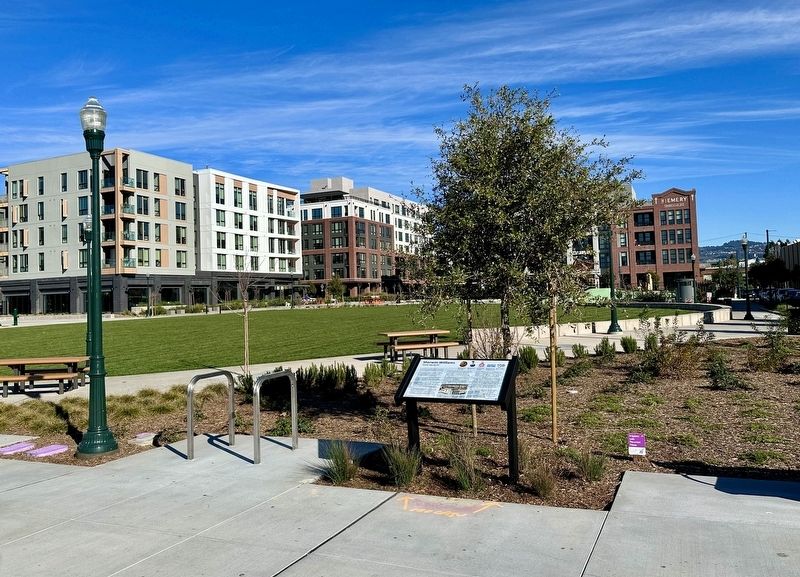Emeryville in Alameda County, California — The American West (Pacific Coastal)
Sherwin-Williams
“Cover the Earth”
For over 85 years, from 1920 to 2007, the area in front of you was the site of a large Sherwin-Williams paint factory. The only remaining structure is "Building I-31", the brick and concrete building at Horton Street and Sherwin Avenue.
The Sherwin-Williams paint company began in Cleveland, Ohio in 1866, when bookkeeper Henry Sherwin invested his life savings of $2,000 in Truman Dunham & Co., a paint distributorship. In 1870, he was joined by Edward Williams and in 1873 they opened their first paint factory.
In 1884, the company was incorporated as Sherwin-Williams, with sales agents in New York and Chicago. By the early 20th Century, the company was large enough to establish two additional factories outside Cleveland, one in Newark, New Jersey, and the other on this site in Emeryville.
The Emeryville plant cost about a million dollars to build in 1920 (that would have been about $14 million in 2020 dollars). According to the Oakland Tribune, Building I-31 served as "a great warehouse and the general offices of the company. It is here that the general manager of the entire Pacific Coast district makes his headquarters and from this point that all of the business of the Pacific Coast is directed."
In 1936, when the Bay Bridge opened to traffic and Treasure Island was built for the Golden Gate International Exposition, the Sherwin-Williams paint factory was readily visible to the general public for the first time. To take advantage of its newly-prominent location, the company erected a huge sign atop Building I-31. Measuring 75 feet tall by 320 feet wide, it was one of the largest rooftop neon signs west Chicago.
In 1974, concerned that the old "Cover the Earth” logo "did not reflect an environmentally aware, diversified manufacturer," the company decided to rebrand itself. Reflecting these concerns, the sign went dark forever in 1976 and was demolished in 1977. However, responding to consumer backlash and unable to come up with a more iconic symbol, the company reinstated the "Cover the Earth” logo in 1979.
During its first 67 years of operations, the Emeryville factory produced several toxic products, including lead- arsenate pesticides, and oil-based paints and varnishes. In 1987, it switched to water-based paint for its last 20 years of operations. But by then, the soil and groundwater were contaminated with a toxic soup of chemicals, including arsenic, lead, and volatile organic compounds (VOC).
In the late 1990s, facing orders from the State to clean up the site, Sherwin-Williams decided to replace its aging Emeryville facility. Decommissioning of the factory begin in 2006 and it closed its doors in 2007, replaced by a $10.7 million state-of- the-art plant in Fernley, Nevada, about 36 miles east of Reno. This new facility, known as the Sherwin-Williams Western Emulsion Plant, manufactures only water-based latex paint.
A Remedial Action Plan for the Emeryville site was approved by the State Department of Toxic Substances Control (DTSC) in June 2010. It called for removing 57,000 cubic yards of lead, arsenic, and VOC contaminated soil from the site and installing sub-surface remedial features, including an underground dam, to control the arsenic contaminated groundwater. Fortunately, the old rail spur that had brought raw materials for paint manufacturing to the factory was still in place, so some of the soil was hauled away in railroad cars, thereby eliminating hundreds of truck trips through the neighborhood. These remediation efforts took place in 2011-2012, and in January 2013, DTSC issued a "Certificate of Completion".
Later in 2013, planning began to redevelop the site with a mixed-use project. In November 2016, the Emeryville City Council approved a "Planned Unit Development" consisting of 500 housing units in four new buildings (including 85 affordable units), the adaptive reuse of Building I-31 for research and development, and 3.5 acres of public open space, including a new City park and extension of the Emeryville Greenway.

3. Marker photo and caption: Sherwin-Williams sign
The iconic Sherwin-Williams sign could be seen from across the Bay. In existence for 38 years from 1939 to 1977, it was composed of 30 tons of steel, 15,000 square feet of sheet metal, six miles of electrical wire, one mile of neon tubing, 100 transformers, and 50 gallons of paint. There were more than 58 different actions in the elaborate animated "cover the earth” effect, which made the sign spectacular at night.
Erected 2023 by City of Emeryville.
Topics. This historical marker is listed in these topic lists: Industry & Commerce • Parks & Recreational Areas.
Location. 37° 49.894′ N, 122° 17.434′ W. Marker is in Emeryville, California, in Alameda County. Marker is at the intersection of Sherwin Avenue and Halleck Street, on the left when traveling north on Sherwin Avenue. The marker is located in the southwest corner of Huchiun Park, at the southern end of the Emeryville Greenway. Touch for map. Marker is in this post office area: Emeryville CA 94608, United States of America. Touch for directions.
Other nearby markers. At least 8 other markers are within walking distance of this marker. Welcome to the Emeryville Greenway (here, next to this marker); Xučyun Park (Huchiun Park) (within shouting distance of this marker); Judson Manufacturing (within shouting distance of this marker); Two Emeryville Pioneers (about 500 feet away, measured in a direct line); Emeryville’s Mexican Heritage (about 800 feet away); Emeryville’s Horse Racetrack (approx. 0.2 miles away); Northern Railway (approx. ¼ mile away); Moving Shoreline (approx. ¼ mile away). Touch for a list and map of all markers in Emeryville.
Also see . . . Sherwin-Williams (Wikipedia).
Excerpt: Sherwin-Williams dates from 1866, when Cleveland bookkeeper Henry Sherwin invested in Truman Dunham & Co., a paint distributorship. After the partnership dissolved in 1870, he formed Sherwin, Williams, & Co. with Edward Williams and A.T. Osborn. For its first factory, in 1873 the company acquired a cooperage in Cleveland from Standard Oil.(Submitted on January 5, 2024.)
Sherwin-Williams was incorporated in Ohio on July 16, 1884, two years after Osborn sold his interest in the company while retaining the retail operations. The company grew through acquisitions and expansions in the late 19th and early 20th century. In the early 1920s, the company became the largest coatings manufacturer in the U.S.
Credits. This page was last revised on January 5, 2024. It was originally submitted on January 5, 2024, by Andrew Ruppenstein of Lamorinda, California. This page has been viewed 71 times since then. Photos: 1, 2, 3. submitted on January 5, 2024, by Andrew Ruppenstein of Lamorinda, California.

